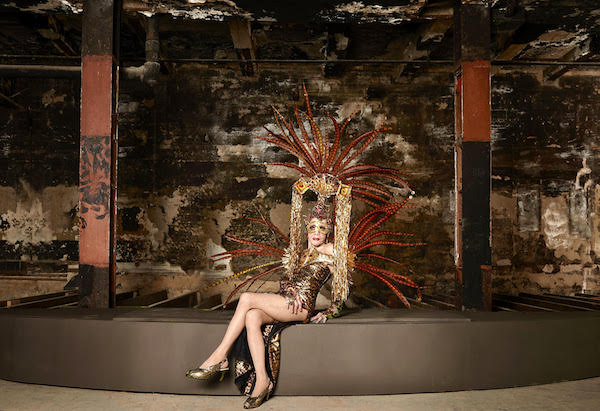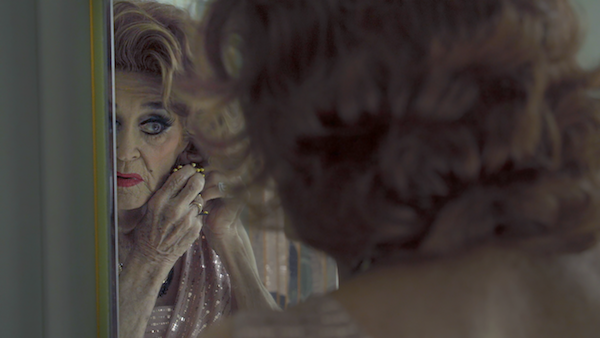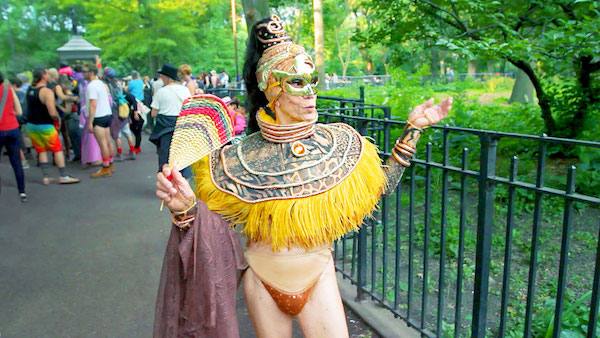
REVIEW BY WINNIE McCROY | If you like your LGBTQ documentaries with a bit of history, a soupçon of mystery, and a hell of a lot of drag queens, P.S. Burn This Letter Please fits the bill to a gay tee.
The 100-minute film follows director Michael Seligman and Jennifer Tiexiera’s exploration of a box of letters held in secret for nearly 60 years by a Hollywood bigwig, and found in a storage unit four years after his death.
“Reno’s group of friends were 1950s New York City drag queens. Their letters brought to life people, places, and events from a forgotten time in LGBTQ history,” notes a title card in the film’s early moments. It was a time, we see repeatedly, when being true to yourself brought swift and severe legal and societal punishments.
The filmmakers weave together archival footage with their own original interviews of pre-Stonewall drag queens and female impersonators now in their 80s and 90s. It reveals how they survived, even thrived, in an era when drag queens were sometimes revered but mostly reviled, even by other gay men. We learn about their lives, the active epistolary relationship between the men and their friend, Reno Martin, and the infamous theft of nearly the entire wig stock of the Metropolitan Opera. (Spoiler: The drag queens did it, as “Josephine” writes to Reno, with a postscript asking him to “burn this letter please.”)
As we discover, “Reno Martin” is actually Hollywood talent agent and former radio DJ Ed Limato (1936-2010), who represented Denzel Washington, Richard Gere, Diana Ross, Mel Gibson, and Michelle Pfeiffer. Many of his friends began their careers in the military, several being drummed out by dishonorable discharge for being gay.
Lennie, an 89-year-old former drag queen who went by the name Dee Dee LaRue, left his home near Hershey, PA, after his brothers reacted negatively to him being the town’s first male cheerleader. He joined the Navy at 18, and found a way to do drag—as a singing, stripping, featured act in the ship’s annual production (Sound Off of 1953, in this particular case).
“We did two shows,” said Lennie, recalling how for the second performance, “I had to get an escort to come from where I got dressed, to go on stage. Because the guys thought a real girl must have got onto the ship somehow-–and if it wasn’t, it was the closest thing to it, and they were going to try to get it, I guess.”
He recalls being given weekend liberty in New Orleans, along with a list of those bars prohibited to servicemembers. All the gay bars were included, and it became a map of where to party.

Servicemember Robert Ross went out in drag into the “absolutely jam-packed” streets of New Orleans, and remembers, “It seemed like people were just parting to let me get through,” causing Ross to think, “You must really look good, if you’re getting a pathway opening up for you.” And that, he notes, is “how the whole drag thing began.”
Ross got a “undesirable” discharge with no benefits, no veterans’ rights, and the final words from his Chaplain, that he had “given this base the worst reputation of any Air Force base in the United States, because of your gay activities!” Ross tore up the discharge and moved on with life.
These men headed to New York City, of which James said, “The minute I stepped off the bus, I felt I was where I was meant to be. It was fabulous!” The men would cruise the streets of Greenwich Village at night looking for “trade”—straight men seeking gay sex.
Italian Michael was always into dressing up, saying his older sister often caught him in her closet wearing her dresses. She never scolded, just warned, “Mickey, don’t let Momma see you wearing that.” His father took him to the opera but blanched when Michael told him he wanted to be Madame Butterfly when he grew up. Later, his Sicilian father scolded again while bailing him out of jail, where he was “painted up” with all the other “Susies.”
By 1957, things started becoming really dangerous. “The mere presence of a lesbian or gay man in a bar meant that bar was disorderly and could be shut down,” noted George Chauncey, author of Gay New York: Gender, Urban Culture, and the Making of the Gay Male World, 1890-1940.
Tougher queens like Claude Diaz and Robert Perez, aka “Claudia” and “Josephine Baker,” would patronize bars like the Cork Club, where drag queens sat in the booths in the back. They started out with dresses borrowed literally from hookers. Those with money would pay local dressmaker Billy Baker (real name, Billy Norton, Jr.) to make them a knockout dress for ten bucks. But scrappier queens graduated to “mopping”—shoplifting from stores like Bloomingdale’s and the notorious Brooks Costumes, which Claude called, “the biggest contributor to drag queenism in America,” adding, “We found where we all belonged, and we belonged together.”
The drag queens often stuck to the streets, sometimes turning tricks to survive. The best performers got hired to dance at the Lower East Side’s Club 82. The women were men, the waiters were butch lesbians, and the clientele was straight—not only celebs like Liz Taylor, Richard Burton, and the Kennedys, but, “Your mom and dad, heterosexual couples in tour buses that spent their night out gawking at gay people.”
The club was run by mob boss Vito Genovese’s second wife, Anna, as a lot of money could be made off the so-called “gay tax.” But one performer, Terry, remembers how Anna made sure her personal doctor would see her weekly for hormone shots and made sure she had pills to take daily. “And he didn’t charge me a cent,” noted Terry. “Not only that—he arranged for my surgery… Some thought it was the worst thing you could do; they called it self-mutilation. I thought yeah, maybe, but it’s gonna allow me to have the life I want.”
The mystery at the heart of this documentary concerns the theft of $3,000 worth of Italian lace-front wigs from the Metropolitan Opera. Josephine and Claudia had heard about a gay costume party and vowed to get some wigs for it, by hook or by crook. They pulled a heist and sold the wigs they didn’t want to other drag queens. They were eventually caught and forced to return 17 of the 33 wigs. But did they really?
“We gave them back cheap synthetic wigs, and the cops didn’t know the difference.” They were arrested only for breaking and entering,” noted Claude, We were arrested only for breaking and entering. This brown one was part of Rigoletto, the opera,” said Claude, holding a wig up for the filmmakers. “It was a big ‘fuck you’ to the New York Police: You couldn’t find your way out of a closet. And two faggots have both outsmarted you—all of you. And you still don’t know how we got in.”

The documentary follows the era of drag balls held by special permit and in Harlem’s lively gay society, creating the first gay, racially integrated spaces. Later, it tracks the pilgrimages to Fire Island, the first Pride march, and then, in 1983, the emergence of HIV/AIDS, which claimed the lives of many queens.
Looking at a picture of his old friend, Daphne, killer legs emerging from her zippered gown, Claude begins to cry, saying, “I suddenly feel as though somebody had just stabbed me. Because I remember that night, and I remember putting the wigs on him and pinning them down. His own hair was as black as black can be. Oh, god… I have to keep in mind that that’s over. That’s over and finished and I’m sorry that it’s over and finished. You have no idea.”
These men carved a space for themselves when society—and even the larger gay community—scorned them. “Just being gay in general costs something, particularly in the past,” noted Harlem-based writer, historian, and activist Michael Henry Adams, who spoke about how he admired the “bravery and courage” of these queens to “do such a thing, much less put themselves on stage. It also tells you how committed they were to the art form, to what it was they wanted to present.”
Society gradually moved toward acceptance—and, as the film shows in its final moments—gratitude. But at the time, said George, “We thought nothing of doing it, because we were doing it for ourselves,” said George. “We didn’t realize we were doing it for the next generation.”
Runtime: 100 minutes. Directed by Michael Seligman and Jennifer Tiexiera. Edited by Jennifer Tiexiera, Alex Bohs. Cinematographer, Zachary Shields. Produced by Craig Olsen, Jennifer Tiexiera & Michael Seligman.“P.S. Burn This Letter Please” recently had its premiere screening at the Tribeca Film Festival (Official Selection, Features), will stream on Discovery+ until January 2024, and is currently available on TVOD (iTunes, Amazon, etc.). For more info, visit www.psburnthisletterplease.com. Twitter: @psbtlp. Instagram: @psburnthisletterplease.

Chelsea Community News is made possible with the help of our awesome advertisers, and the support of our readers. If you like what you see, please consider taking part in our GoFundMe campaign (click here). To make a direct donation, give feedback, or send a Letter to the Editor, email scott@chelseacommunitynews.com.

You must be logged in to post a comment Login